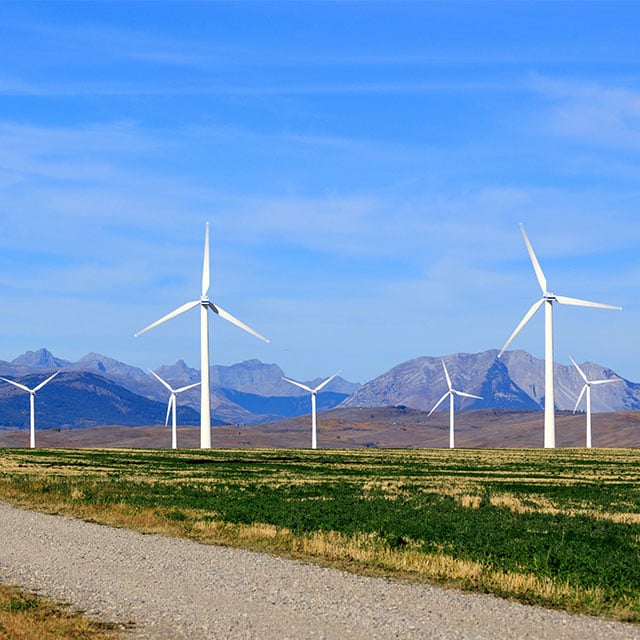The Alberta Utilities Commission's (AUC) government-directed inquiry regarding the key issues of concern with renewable power projects in Alberta (the Inquiry) is underway. See our prior blog post, Update on Alberta's Renewables Pause: AUC Inquiry and Interim Requirements, for an overview of the two-module process. The focus of this post is Module A.
In Module A of the Inquiry, the AUC commissioned four expert reports related to three specific land impact issues associated with power generation projects: (1) reclamation security, (2) impacts to agricultural lands, and (3) impacts to Alberta's pristine viewscapes. The AUC released the reports, which provide dozens of recommendations, on November 10, 2023. While the expert reports emphasize renewable projects, the ultimate requirements from the inquiry may apply to all power projects.
The reports' recommendations are not final or binding. They will be considered by the AUC along with stakeholder feedback as it prepares its final report to the Minister of Affordability and Utilities. The AUC recently indicated it intends to deliver the report for Module A by the end of January 2024.
This post provides a summary of the reports and recommendations and discusses the AUC's next steps in Module A of the Inquiry. The AUC will be providing an opportunity for interested parties to make oral submissions and specific details are set out below.
Reclamation Security
Two of the reports addressed reclamation security requirements (RSRs), recommending more stringent requirements to cover clean-up costs when renewable projects reach the end of life. The recommendations are based on regulatory frameworks for RSRs across North America, Europe, Australia, and New Zealand. The RSRs would be available to the power plant approval holder to perform reclamation and, if they fail to meet reclamation requirements, to the AUC to perform the work itself.
The reports include the following recommendations:
- The establishment of a Liability Management Framework, incorporating multiple financial and non-financial mechanisms. As part of this framework, end-of-life commitments would be set out at the beginning of a project between landowners, the AUC, and approval holder as conditions to an AUC power plant approval (either by approving a negotiated reclamation agreement or imposing standalone conditions). This proposed plan would include requirements for two fully costed application components: (a) interim reclamation to be completed after construction or installation, to return as much land back to productive use as possible, and (b) end of life reclamation, to return the site to equivalent land capability, with such costs to be revisited and agreed to by all parties every five years through an updated and renegotiated decommissioning and reclamation plan. Power plant approval holders would be required to provide upfront security commensurate with interim reclamation costs, with a percentage of RSRs returned if interim reclamation targets are met. Under this framework, expected salvage value would be calculated in determining end-of-life closure costs.
- Approval holders may use the estimated salvage value of their infrastructure to reduce the amount of security to be provided by up to a maximum of 50 percent of salvage value. The salvage value would be determined by an independent auditor every five years.
- The AUC is to provide a detailed guideline to create a more rigid and formulaic approach to defining cost estimation parameters, acceptable security instruments, and means of accumulating funds for RSRs.
- A bank guarantee is the preferred form of security, and it is to be issued by a reputable third-party financial institution located in Alberta. Such security would be provided before construction, as funds accumulate in an escrow account over the plant's life, forming part of its capital reserve. If a power plant owner were to default on their reclamation obligations, the AUC could call on the bank guarantee, requiring the applicable financial institution to transfer the funds to the AUC to facilitate performance of those obligations. If the plant owner demonstrates that the bank guarantee imposes "undue financial hardship", the AUC may, in its discretion, accept a flexible payment schedule from the owner.
- Approval holders of varying financial positions should be treated equitably in the establishment of RSRs. In other words, financially strong power plant owners should generally be required to provide the same amount and form of security as compared to others. This recommendation deviates from the Liability Management Rating system implemented in Alberta for oil and gas wells, which uses an asset-to-liability ratio to inform security requirements.
Agricultural Land
The reports include the following agricultural land use recommendations, based on the implementation of an "agriculture first" approach to mitigating power plant impacts:
- Implementation of a four-tiered approach to categorizing agricultural land values. This would include specific requirements for maintaining agricultural land productivity and categorizing lands from "very high to high value land" to "low to very low value land", based on a yet-to-be-developed Agricultural Land Quality Model (ALQM) that incorporates available land and soil data.
- More stringent restrictions and mitigations would be established for energy projects sited on higher value agricultural land.
- All relevant data is to be provided at the application stage to ensure that agricultural land quality is assessed, and appropriate mitigation measures are included. Under this model, power plant proposals could be denied by the AUC on the basis of preserving lands for agricultural uses, despite a landowner's preference to use their lands for power plant development. Any such requirements would be highly relevant to future power plant siting and planning decisions, particularly for solar projects.
- The report makes further recommendations regarding: the application of existing oil and gas reclamation criteria1 to power plants on agricultural land; the establishment of a new directive with evaluation criteria for assessing proposed wind and solar energy projects on agricultural land (similar to existing wildlife directives);2 and for the AUC to involve the Ministry of Agriculture and Irrigation and the Ministry of Municipal Affairs through external consultation and referral reports before approving a renewable project. If implemented, these recommendations are likely to result in additional procedural and substantive requirements for renewable project proponents, and potentially a measure of regulatory risk.
Impact on Viewscapes
The report on viewscapes included a literature review of published studies exploring the impacts of power plant development on property values. The report suggests that energy infrastructure may negatively influence the value of nearby properties due to visual impacts, but also notes that many studies report no or mixed impacts, and that attitudes and impacts may change as electricity generation sources continue to change. It does not make any specific recommendations regarding regulatory requirements or government policies related to viewscapes.
Next Steps in the Module A Process
Since the reports were released, numerous stakeholders representing various interests have filed substantial comments with the AUC. Submissions range from brief written statements by individual Albertans to independent expert reports commissioned specifically to address the conclusions and recommendations in the above reports. All written submissions are publicly available.
In addition to incorporating this written feedback, the AUC has invited interested parties to make brief oral submissions to the AUC in Module A via Zoom. Oral submissions from members of the general public are scheduled for the week of December 4, 2023, and submissions from organizations are scheduled for the week of December 11, 2023. The latter includes submissions from municipalities, First Nations, Métis communities, corporations, industry associations and other groups. The AUC has also suggested it may have questions for certain parties based on the written submissions, which questioning will also occur orally in December.
The time available for oral submissions is limited and will be allocated based on demand (see information here).
In a letter dated November 24, 2023, the AUC stated that, "[t]o assist with the Alberta government’s intent to develop new policy frameworks in a timely way", it intends to deliver its report for Module A to the Minister by the end of January 2024, ahead of the March 29, 2024, deadline.
We will continue to follow developments related to the renewables pause, AUC Inquiry and the development of power projects in Alberta. If you have any questions on these or other ongoing developments in the rapidly evolving electric power sector, please contact one of the authors of this post or members of the firm's Energy Regulatory practice group.
2 See Wildlife Directive for Alberta Wind Energy Projects - https://open.alberta.ca/dataset/2d992aec-2437-4269-9545-cd433ee0d19a/resource/e77d2f25-19dc-4c9e-8b87-99d86cd875f1/download/wildlifewindenergydirective-sep17-2018.pdf ; see also Wildlife Directive for Alberta Solar Energy Projects - https://open.alberta.ca/publications/directive-aep-fish-and-wildlife-2017-no-5 (Both issued by Alberta Environment and Protected Areas, formerly Alberta Environment and Parks).























